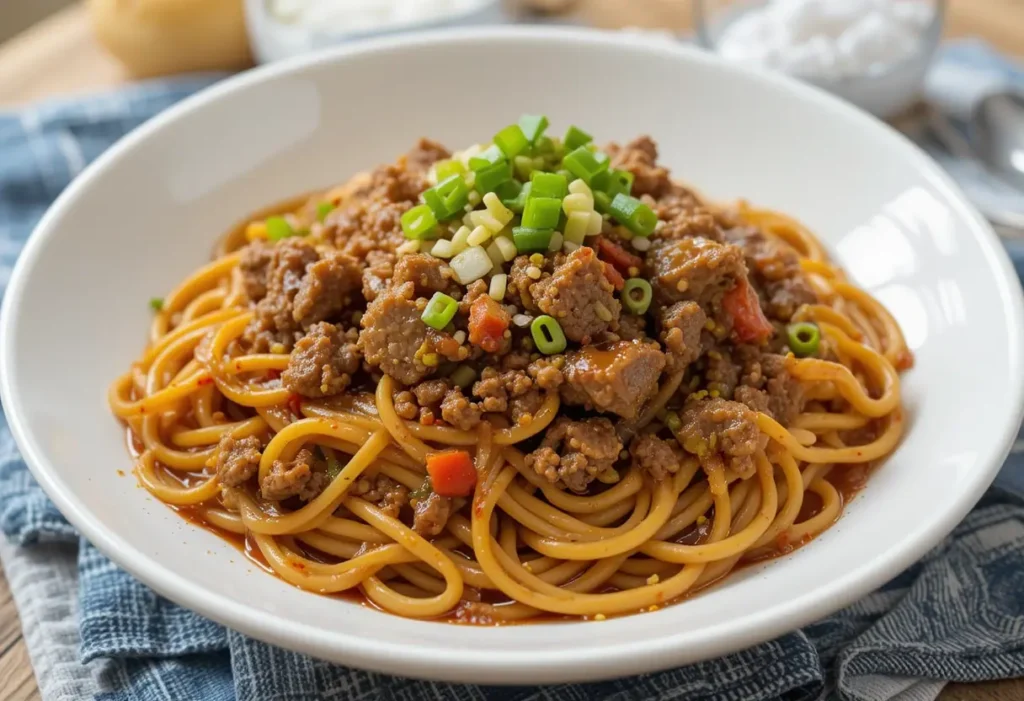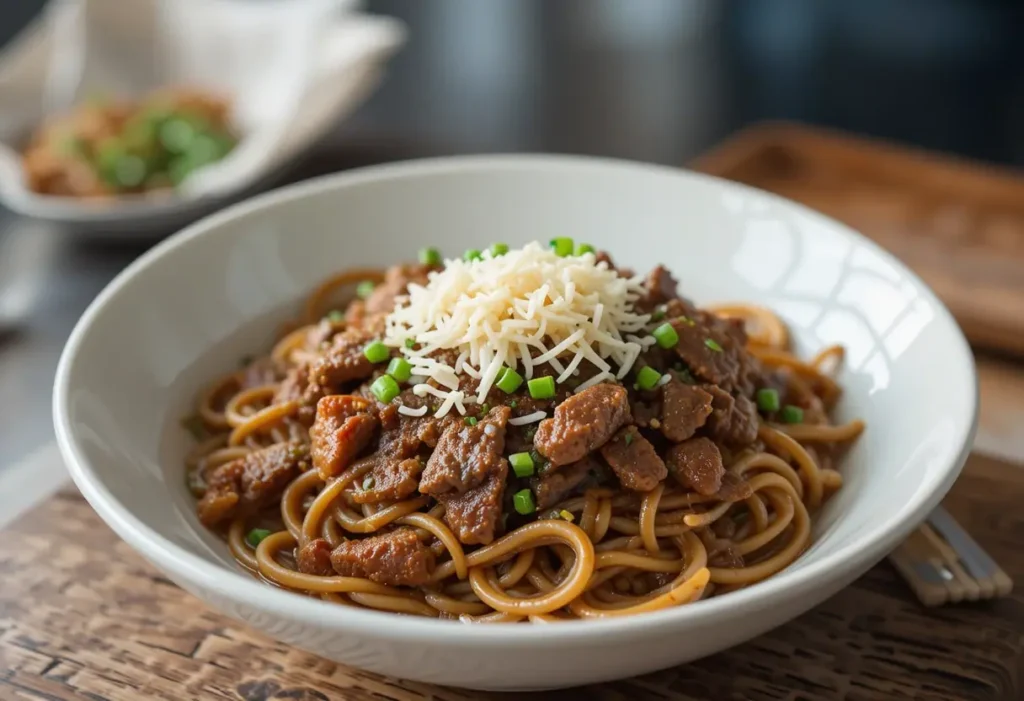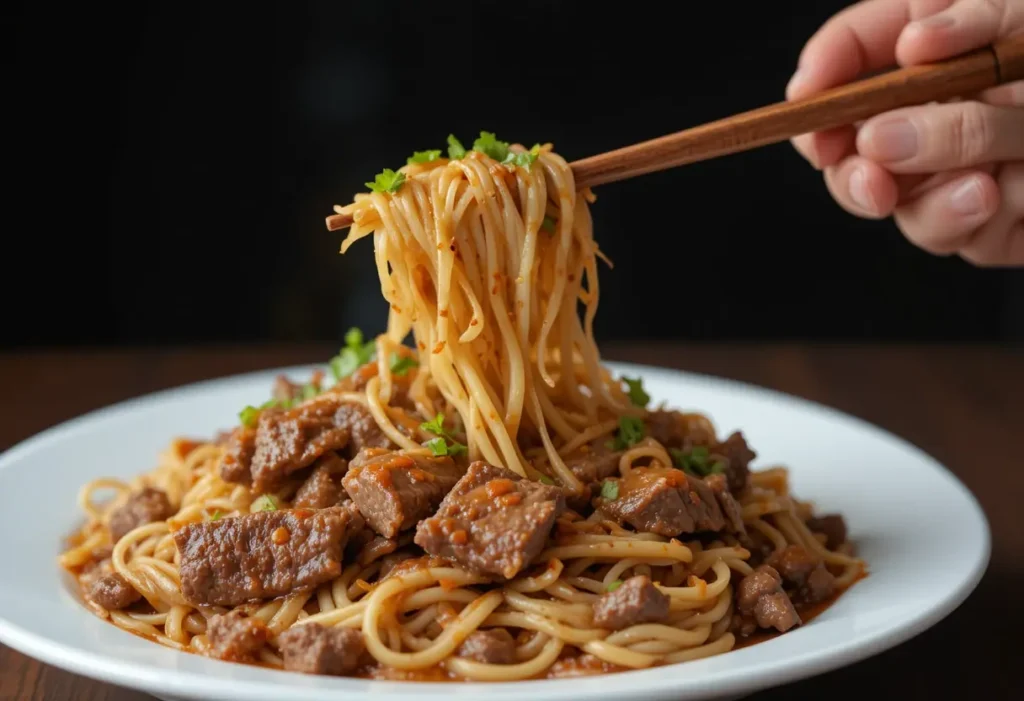Mongolian beef noodles are a beloved dish known for their tender beef slices, hearty noodles, and rich, savory-sweet sauce. But despite the name, this dish has no roots in traditional Mongolian cuisine. So where exactly did Mongolian beef noodles originate? Let’s dive into the fascinating story behind this culinary favorite.
Not from Mongolia: The Common Misconception
Despite its name, Mongolian beef noodles are not part of authentic Mongolian cuisine. Traditional Mongolian dishes are centered around simple, hearty ingredients like mutton, root vegetables, and dairy. A prime example is Tsuivan, a stir-fried noodle dish made with meat and vegetables, but it’s quite different from what most people recognize as Mongolian beef noodles.
- Key Features of Authentic Mongolian Cuisine:
- Simple, rustic ingredients like mutton and root vegetables
- Minimal seasoning, emphasizing natural flavors from meat and dairy
- Flat noodles, but without the rich, soy-based sauces found in Mongolian beef noodles
Curious about real Mongolian food? Check out this overview of traditional Mongolian cuisine.
Taiwanese Origins of Mongolian Beef Noodles
The true origin of Mongolian beef noodles lies in Taiwan during the mid-20th century. After World War II, Chinese immigrants in Taiwan began fusing regional flavors to create new dishes that catered to local tastes. One of these creations was Mongolian beef noodles.
- Why the Name “Mongolian”?
It was a clever marketing strategy designed to give the dish an exotic flair. This tactic wasn’t unique to Mongolian beef noodles. Other dishes like chop suey and fortune cookies were also given names to evoke curiosity and attract diners, even though their origins were far from what their names suggested.
If you’re interested in the backstory of Mongolian beef itself, you can explore the origins of Mongolian beef and how it evolved.

Spread to Chinese-American Cuisine
After gaining popularity in Taiwan, Mongolian beef noodles made their way to Chinese-American cuisine, where they were further adapted to suit Western palates. The flavors became sweeter and richer, and the dish evolved into the version many of us enjoy today.
- Chinese-American Influence:
- Sweeter sauces made with hoisin and brown sugar
- Greater emphasis on beef with fewer vegetables
- Commonly served alongside fried rice or lo mein
For a deeper look at how Mongolian beef noodles transformed from their Taiwanese roots to the U.S. takeout menus, check out this detailed history of Mongolian beef noodles.
What Are Mongolian Beef Noodles?
At its core, Mongolian beef noodles balance savory, sweet, and umami flavors. The dish is simple yet bursting with flavor, thanks to its well-chosen ingredients.
- Core Components:
- Beef: Thinly sliced marinated flank steak or sirloin, cooked until tender
- Noodles: Typically glass noodles or egg noodles that soak up the flavorful sauce
- Sauce: A blend of soy sauce, hoisin, garlic, ginger, and a touch of sweetness
- Vegetables: Common additions include onions, scallions, and bell peppers
Want to know more about the core ingredients of this dish? Learn about the core ingredients of Mongolian noodles.
Regional Variations and Modern Adaptations
As Mongolian beef noodles spread across the globe, they were adapted to fit local tastes and dietary needs. Today, the dish comes in various forms, each offering its unique twist.
- Chinese-American Style:
- Sweeter and richer, with more sauce
- Popular in takeout menus across the U.S.
- Authentic Chinese Style:
- Focus on fresh ingredients and balanced flavors
- Less sweetness, highlighting savory aspects
- Modern Adaptations:
- Vegetarian versions using tofu or plant-based proteins
- Spicy versions with chili paste or Sichuan peppercorns
Cultural Significance and Global Popularity
Mongolian beef noodles represent more than just a delicious dish—they’re a symbol of cultural fusion. The dish showcases how culinary traditions evolve as they cross borders, blending local ingredients and techniques with global influences.
- Global Influence:
- Found in Asian fusion restaurants worldwide
- Adapted into different forms, from noodle bowls to wraps
- Enjoyed by both meat-eaters and vegetarians due to its versatile recipe
If you’re curious about why this dish has become so beloved globally, find out what makes Mongolian beef unique in flavor and preparation. cuisine.

How to Make Mongolian Beef Noodles at Home
Making Mongolian beef noodles at home is easier than you might think. Here’s a quick step-by-step guide to help you prepare this savory dish.
- Marinate the Beef:
Use soy sauce, ginger, and garlic to marinate thinly sliced beef for at least 20 minutes. - Cook the Noodles:
Boil glass noodles or egg noodles until they’re al dente. - Prepare the Sauce:
Mix soy sauce, hoisin sauce, brown sugar, and a splash of rice vinegar for a sweet-savory balance. - Stir-Fry:
Sauté the marinated beef with vegetables like onions and bell peppers. Add the noodles and sauce, stirring until everything is well-coated.
Ready to try making this at home? Check out this detailed recipe for making Mongolian beef noodles at home.
FAQs
1. Are Mongolian beef noodles from Mongolia?
No, they originated in Taiwan and became popular through Chinese-American cuisine.
2. What are authentic Mongolian noodle dishes?
Traditional Mongolian dishes include Tsuivan, a stir-fried noodle dish with mutton and vegetables.
3. Can Mongolian beef noodles be made vegetarian?
Yes, you can substitute the beef with tofu or other plant-based proteins.
4. Why do Chinese-American dishes have exotic names?
To attract diners and spark curiosity, many dishes were given names that sounded exotic or intriguing.
Conclusion
While Mongolian beef noodles might sound like a dish from Mongolia, their true story is one of Taiwanese creativity and Chinese-American innovation. This flavorful dish exemplifies how culinary traditions evolve, blending ingredients and techniques from different cultures to create something new and delicious. Whether you’re a fan of sweet and savory flavors or simply love a good noodle dish, Mongolian beef noodles are a must-try!

